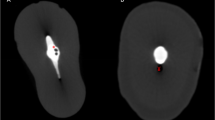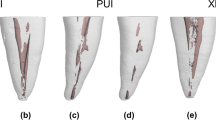Abstract
Objectives
The aim of this study was to assess the filling quality of five obturation techniques in oval-shaped root canals.
Materials and methods
A total of 212 mandibular first molars with one distal oval canal were selected. Distal canals, shaped with WaveOne Gold Primary, were randomly divided in five groups (n = 40) for obturation: continuous wave condensation, GuttaCore, Thermafil, single cone with AH plus, and single cone with BioRoot RCS. The proportions of gutta-percha-filled areas (GPFA), sealer-filled areas (SFA), void areas (VA), and the sealer/gutta tags into dentinal tubules at 4 mm and 2 mm from the apex were analyzed by an optical numeric microscope, SEM, and energy-dispersive X-ray (EDX). Data were then compared by Kruskal-Wallis one-way ANOVA on ranks (α = 0.05).
Results
At 4 mm, a statistically significant higher GPFA and lower SFA were observed in the GuttaCore and Thermafil groups compared with the 3 other groups. A statistically significant lower VA was observed in the continuous wave condensation, GuttaCore, and Thermafil groups than in the two single-cone groups. At 2 mm, there were a statistically significant higher GPFA and lower SFA and VA in GuttaCore and Thermafil groups than in the 3 other groups. At the two levels investigated, the presence of gutta-percha tags was clearly demonstrated for GuttaCore and Thermafil groups; no tags were observed in the 3 other groups.
Conclusions
Obturation quality was overall improved in GuttaCore and Thermafil groups.
Clinical relevance
Carrier-based techniques may significantly improve the filling quality compared to continuous wave condensation and single-cone technique. The single-cone technique might have inherent limitations especially in oval root canals regardless of the sealer used.







Similar content being viewed by others


References
Haapasalo M, Endal U, Zandi H, Coil JM (2005) Eradication of endodontic infection by instrumentation and irrigation solutions. Endod Top 10:77–102
Li GH, Niu LN, Zhang W, Olsen M, de-Deus G, Eid AA, Chen JH, Pashley DH, Tay FR (2014) Ability of new obturation materials to improve the seal of the root canal system: a review. Acta Biomater 10:1050–1063
Peng L, Ye L, Tan H et al (2007) Outcome of root canal obturation by warm gutta-percha versus cold lateral condensation: a meta-analysis. J Endod 33:106–109
Ray HA, Trope M (1995) Periapical status of endodontically treated teeth in relation to the technical quality of the root filling and the coronal restoration. Int Endod J 28:12–18
Park E, Shen YA, Haapasalo M (2012) Irrigation of the apical root canal. Endod Top 27:54–73
Sundqvist G, Figdor D (1998) Endodontic treatment of apical periodontitis. In: Ørstavik D, Ford TRP (eds) Essential endodontology. Blackwell Science, Oxford, pp 242–277
Keleş A, Alcin H, Kamalak A, Versiani MA (2014) Micro-CT evaluation of root filling quality in oval-shaped canals. Int Endod J 47:1177–1184
Mohammadi Z, Abbott PV (2009) The properties and applications of chlorhexidine in endodontics. Int Endod J 42:288–302
Wu MK, Fan B, Wesselink PR (2000) Diminished leakage along root canals filled with gutta-percha without sealer over time: a laboratory study. Int Endod J 33:121–125
Kontakiotis EG, Wu MK, Wesselink PR (1997) Effect of sealer thickness on long-term sealing ability: a 2-year follow-up study. Int Endod J 30:307–312
Urban K, Neuhaus J, Donnermeyer D, Schäfer E, Dammaschke T (2018) Solubility and pH value of 3 different root canal sealers: a long-term investigation. J Endod 44:1736–1740
Whitworth J (2005) Methods of filling root canals: principles and practices. Endod Top 12:2–24
De-Deus G, Gurgel-Filho ED, Magalhães KM et al (2006) A laboratory analysis of gutta-percha-filled area obtained using Thermafil, System B and lateral condensation. Int Endod J 39:378–383
Guivarc’h M, Jeanneau C, Giraud T et al (2020) An international survey on the use of calcium silicate-based sealers in non-surgical endodontic treatment. Clin Oral Investig 24:417–424
Viapiana R, Moinzadeh AT, Camilleri L, Wesselink PR, Tanomaru Filho M, Camilleri J (2016) Porosity and sealing ability of root fillings with gutta-percha and BioRoot RCS or AH Plus sealers. Evaluation by three ex vivo methods. Int Endod J 49:774–782
Borges RP, Sousa-Neto MD, Versiani MA, Rached-Júnior FA, de-Deus G, Miranda CES, Pécora JD (2012) Changes in the surface of four calcium silicate-containing endodontic materials and an epoxy resin-based sealer after a solubility test. Int Endod J 45:419–428
Poggio C, Dagna A, Ceci M, Meravini MV, Colombo M, Pietrocola G (2017) Solubility and pH of bioceramic root canal sealers: a comparative study. J Clin Exp Dent 9:e1189–e1194
Schneider SW (1971) A comparison of canal preparations in straight and curved root canals. Oral Surg Oral Med Oral Pathol 32:271–275
De-Deus G, Maniglia-Ferreira CM, Gurgel-Filho ED et al (2007) Comparison of the percentage of gutta-percha-filled area obtained by Thermafil and System B. Aust Endod J 33:55–61
de Deus GA, Martins F, Lima AC et al (2003) Analysis of the film thickness of a root canal sealer following three obturation techniques. Pesqui Odontol Bras 17:119–125
Li GH, Niu LN, Selem LC, Eid AA, Bergeron BE, Chen JH, Pashley DH, Tay FR (2014) Quality of obturation achieved by an endodontic core-carrier system with crosslinked gutta-percha carrier in single-rooted canals. J Dent 42:1124–1134
Tedesco M, Chain MC, Bortoluzzi EA, da Fonseca Roberti Garcia L, Alves AMH, Teixeira CS (2018) Comparison of two observational methods, scanning electron and confocal laser scanning microscopies, in the adhesive interface analysis of endodontic sealers to root dentine. Clin Oral Investig 22:2353–2361
Chen JH, Lin PY, Hsu SCY, et al (2009) Imaging dental sections with polarization-resolved SHG and time-resolved autofluorescence Progress in Biomedical Optics and Imaging - Proceedings of SPIE 7183
El Hachem R, Khalil I, Le Brun G et al (2019) Dentinal tubule penetration of AH Plus, BC Sealer and a novel tricalcium silicate sealer: a confocal laser scanning microscopy study. Clin Oral Investig 23:1871–1876
Wang Y, Liu S, Dong Y (2018) In vitro study of dentinal tubule penetration and filling quality of bioceramic sealer. PLoS One 13:e0192248
Sellerer T, Ehn S, Mechlem K, Duda M, Epple M, Noël PB, Pfeiffer F (2019) Quantitative dual-energy micro-CT with a photon-counting detector for material science and non-destructive testing. PLoS One 14:e0219659
Gaêta-Araujo H, Nascimento E, Brasil DM et al (2020) Influence of reconstruction parameters of micro-computed tomography on the analysis of bone mineral density. Imaging Sci Dent 50:153–159
De-Deus G, Belladonna FG, Cavalcante DM et al (2020) Contrast-enhanced micro-CT to assess dental pulp tissue debridement in root canals of extracted teeth: a series of cascading experiments towards method validation. Int Endod J 13. https://doi.org/10.1111/iej.13408. Epub ahead of print
Mancino D, Kharouf N, Hemmerlé J, Haikel Y et al (2019) Microscopic and chemical assessments of the filling ability in oval-shaped root canals using two different carrier-based filling techniques. Eur J Dent 13:166–171
De-Deus G, Reis C, Beznos D et al (2008) Limited ability of three commonly used thermoplasticized gutta-percha techniques in filling oval-shaped canals. J Endod 34:1401–1405
Camilleri J (2015) Staining potential of Neo MTA Plus, MTA Plus, and Biodentine used for pulpotomy procedures. J Endod 41:1139–1145
Venturi M, Pasquantonio G, Falconi M, Breschi L (2002) Temperature change within gutta-percha induced by the System-B Heat Source. Int Endod J 35:740–746
Bowman CJ, Baumgartner JC (2002) Gutta-percha obturation of lateral grooves and depressions. J Endod 28:220–223
Celikten B, Uzuntas CF, Orhan AI et al (2015) Micro-CT assessment of the sealing ability of three root canal filling techniques. J Oral Sci 57:361–366
Johnson WB (1978) A new gutta-percha technique. J Endod 4:184–188
Funding
The work was supported by the Department of Endodontics and conservative dentistry at Faculty of Dental Medicine, Strasbourg, France.
Author information
Authors and Affiliations
Corresponding author
Ethics declarations
Conflict of interest
The authors declare that they have no conflict of interest.
Ethical approval
All procedures performed in this study were in accordance with the ethical standards of the Ethics Committee of Medical Odontology School, and Strasbourg University Hospital (protocol no. 2018-89) and with the 1964 Helsinki declaration and its later amendments or comparable ethical standards.
Informed consent
Informed consent was obtained from all individual participants included in the study.
Additional information
Publisher’s note
Springer Nature remains neutral with regard to jurisdictional claims in published maps and institutional affiliations.
Rights and permissions
About this article
Cite this article
Mancino, D., Kharouf, N., Cabiddu, M. et al. Microscopic and chemical evaluation of the filling quality of five obturation techniques in oval-shaped root canals. Clin Oral Invest 25, 3757–3765 (2021). https://doi.org/10.1007/s00784-020-03703-9
Received:
Accepted:
Published:
Issue Date:
DOI: https://doi.org/10.1007/s00784-020-03703-9


